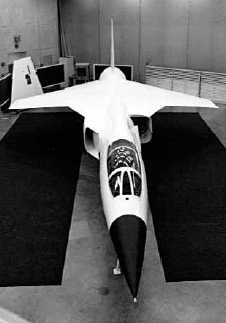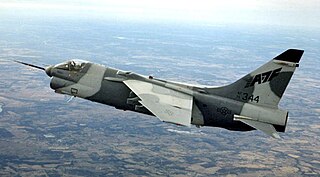Related Research Articles

The LTV A-7 Corsair II is an American carrier-capable subsonic light attack aircraft designed and manufactured by Ling-Temco-Vought (LTV).

The Northrop/McDonnell Douglas YF-23 is an American single-seat, twin-engine stealth fighter aircraft technology demonstrator designed for the United States Air Force (USAF). The design was a finalist in the USAF's Advanced Tactical Fighter (ATF) competition, battling the Lockheed YF-22 for a production contract. Two YF-23 prototypes were built, nicknamed "Black Widow II" and "Gray Ghost".

The Yakovlev Yak-38 was Soviet Naval Aviation's only operational VTOL strike fighter aircraft in addition to being its first operational carrier-based fixed-wing aircraft. It was developed specifically for, and served almost exclusively on, the Kiev-class aircraft carriers.

The Boeing YC-14 is a twinjet short take-off and landing (STOL) tactical military transport aircraft. It was Boeing's entrant into the United States Air Force's Advanced Medium STOL Transport (AMST) competition, which aimed to replace the Lockheed C-130 Hercules as the USAF's standard STOL tactical transport. Although both the YC-14 and the competing McDonnell Douglas YC-15 were successful, neither aircraft entered production. The AMST project was ended in 1979 and replaced by the C-X program.

The McDonnell Douglas YC-15 is a prototype four-engine short take-off and landing (STOL) tactical transport. It was McDonnell Douglas' entrant into the United States Air Force's Advanced Medium STOL Transport (AMST) competition to replace the Lockheed C-130 Hercules as the USAF's standard STOL tactical transport. In the end, neither the YC-15 nor the Boeing YC-14 was ordered into production, although the YC-15's basic design would be used to form the successful McDonnell Douglas C-17 Globemaster III.

The Sukhoi Su-47 Berkut, also designated S-32 and S-37 during initial development, was an experimental supersonic jet fighter developed by the JSC Sukhoi Company. A distinguishing feature of the aircraft was its forward-swept wing that gave the aircraft excellent agility and maneuverability. While serial production of the type never materialized and the configuration was not further pursued, the sole aircraft produced served as a technology demonstrator prototype for a number of advanced technologies later used in the 4.5 generation fighter Su-35 and current fifth-generation jet fighter Su-57.

The Lockheed CL-1200 Lancer was a late 1960s company-funded proposal for a fighter aircraft based on the Lockheed F-104 Starfighter. The CL-1200 was conceived and marketed mainly for and to non-US military services, as an export product. As such it would have competed with combat-proven designs like the Dassault Mirage III, McDonnell Douglas F-4 Phantom II, Mikoyan-Gurevich MiG-21, and Northrop F-5E Tiger II. The CL-1200 competed unsuccessfully against proposed fourth generation designs, under the US government's Lightweight Fighter program, which would eventually result in the General Dynamics F-16 and Northrop F-17 Cobra.

The General Dynamics F-16XL is a derivative of the F-16 Fighting Falcon, with a cranked-arrow delta wing. It was originally conceived as a technology demonstrator, later entered in the United States Air Force's (USAF) Enhanced Tactical Fighter (ETF) competition but lost to the F-15E Strike Eagle. Several years after the prototypes were shelved, they were turned over to NASA for additional aeronautical research. Both aircraft are currently stored at Edwards Air Force Base.

The Scaled Composites ARES is a demonstrator aircraft built by Scaled Composites. ARES is an acronym for Agile Responsive Effective Support.

The XB-59, Boeing model number 701, was a 1950s proposal for a United States supersonic bomber aircraft.

The Dassault Mirage IIIV, also spelled Mirage III V, was a French vertical take-off and landing (VTOL) prototype fighter aircraft of the mid-1960s developed and produced by Dassault Aviation.
The Hawker Siddeley P.1154 was a planned supersonic vertical/short take-off and landing (V/STOL) fighter aircraft designed by Hawker Siddeley Aviation (HSA).

The Ilyushin Il-102 was a Soviet experimental jet-powered ground-attack aircraft designed by Ilyushin. Once described as the "most gorgeously ugly combat jet ever," this aircraft was never chosen for production, being surpassed by the Su-25. Only a few development prototypes were built.

The Nanchang J-12 was a lightweight supersonic fighter built by the People's Republic of China, intended for use by the People's Liberation Army Air Force (PLAAF). It was one of the first serious attempts by Chinese aircraft manufacturers to develop an indigenous, modern jet fighter. Weighing 3,172 kg (6,993 lb) empty, the J-12 is one of the lightest jet fighters ever built. However, neither the J-12 nor the related Shenyang J-13 project entered service.

The Rockwell XFV-12 was a prototype supersonic United States Navy fighter which was built in 1977. The XFV-12 design attempted to combine the Mach 2 speed and AIM-7 Sparrow armament of the McDonnell Douglas F-4 Phantom II in a VTOL fighter for the small Sea Control Ship which was under study at the time. On paper, it looked superior to the subsonic Hawker Siddeley Harrier attack fighter. However it was unable to demonstrate an untethered vertical takeoff and its inability to meet performance requirements terminated the program.

The FMA SAIA 90 was a cancelled air superiority fighter aircraft project, designed by the FMA with the collaboration of Dornier in the mid-1980s. The SAIA 90 was the last stage of the ACA project, which was started by the National Reorganization Process to develop an Argentine fighter aircraft.
The Shenyang J-13 was a long-running Chinese project by Shenyang Aircraft Corporation to develop a light-weight, single engine fighter aircraft, that was ultimately cancelled.

The Vought YA-7F "Strikefighter" is a prototype transonic attack aircraft based on the subsonic A-7 Corsair II. Two prototypes were converted from A-7Ds. The YA-7F was not ordered into production, its intended role being filled by the F-16 Fighting Falcon.

The ALR Piranha was an aircraft project undertaken by the Swiss Air Force's Swiss Working Group for Aerospace (ALR) to develop a lightweight multi-role combat aircraft with canard wings. The ALR is the Aerospace Project Development Group of the Swiss Air Force. The project was managed by Bridel, an engineer at the ETH Zurich.

The British Aerospace (BAe) P.1216 was a planned Advanced Short Take Off/Vertical Landing (ASTOVL) supersonic aircraft from the 1980s. It was designed by the former Hawker design team at Kingston upon Thames, Surrey, England that created the Harrier family of aircraft.
References
Citations
- 1 2 3 Williams 1983
- ↑ Flight International 13 February 1982
- ↑ "Fighter Aircraft". Parliamentary Debates (Hansard) . Vol. 449. New Zealand: House of Representatives. 17 December 1982. p. 5799. Retrieved 6 July 2020.
- ↑ Taylor 1982 , p. 807
- 1 2 Taylor 1982, pp. 807–808
- ↑ Taylor 1982 , p. 808
Bibliography
- Taylor, John W. R., ed. (1982). Jane's All the World's Aircraft 1982–83. London: Jane's Yearbooks. ISBN 0-7106-0748-2.
- Williams, David (April 1983). "From VAX to ADDAX: The Story So Far". Air International . pp. 177–178, 205–206.
- "Kiwis Design a Tank-Killer for Farmers". Flight International . Vol. 121, no. 3797. 13 February 1982. p. 339. ISSN 0015-3710. Archived from the original on 12 August 2017.